

CBSE Class 9 Science Notes Chapter 4: In Chapter 4 of CBSE Class 9 Science, we're going to talk about atoms. Atoms are like tiny building blocks that make up everything around us. We'll learn about how scientists discovered what atoms are made of and how they're put together. From the earliest ideas about atoms to the modern understanding, we'll cover it all.
By the end of this chapter, you'll have a better understanding of how everything in the world is made up of these tiny, invisible particles called atoms.CBSE Class 9 Science Notes Chapter 4 Structure of the Atom Overview
These notes on Chapter 4, "Structure of the Atom," for CBSE Class 9 Science have been prepared by subject matter experts. They aim to provide students with a clear and detailed understanding of the fundamental concepts related to the structure of atoms. With detailed explanations and illustrative examples, these notes are an invaluable resource to aid students in mastering the complexities of atomic theory.CBSE Class 9 Science Notes Chapter 4 PDF
The PDF link provided below for CBSE Class 9 Science Notes Chapter 4 provide students a convenient resource for studying this important topic. This comprehensive notes covers important concepts such as the states of matter, physical properties, and changes of state in a clear and concise manner.CBSE Class 9 Science Notes Chapter 4 PDF
CBSE Class 9 Science Notes Chapter 4 Structure of the Atom
Atom
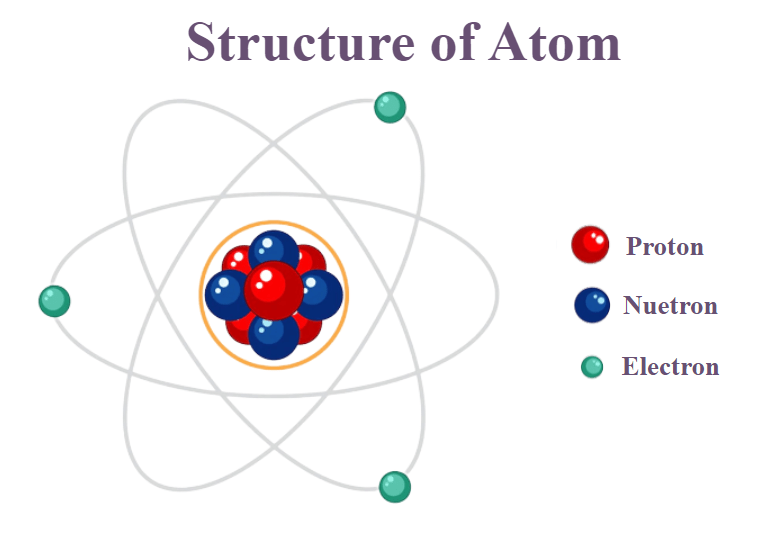 Atoms are the basic units of matter, forming the foundation of all substances in the universe. Comprising three subatomic particles—protons, neutrons, and electrons—atoms exhibit unique properties based on their composition. Protons, with a positive charge, and neutrons, which are neutral, reside in the atom's nucleus, while electrons, negatively charged, orbit around the nucleus in specific energy levels or shells. This intricate structure enables atoms to interact with one another, forming the diverse array of elements and compounds observed in nature.
Atoms are the basic units of matter, forming the foundation of all substances in the universe. Comprising three subatomic particles—protons, neutrons, and electrons—atoms exhibit unique properties based on their composition. Protons, with a positive charge, and neutrons, which are neutral, reside in the atom's nucleus, while electrons, negatively charged, orbit around the nucleus in specific energy levels or shells. This intricate structure enables atoms to interact with one another, forming the diverse array of elements and compounds observed in nature.
Cathode Ray Experiment
The Cathode Ray Experiment, conducted by J. J. Thomson, was a pivotal scientific investigation that led to the discovery of electrons. In this experiment, Thomson used a vacuum-sealed glass tube with electrodes at each end: a cathode (negative electrode) and an anode (positive electrode). When a high voltage was applied across the electrodes, a beam of particles traveled from the cathode to the anode. Thomson observed that regardless of the type of gas in the tube or the material of the electrodes, the particles always moved in the same manner, indicating they were fundamental constituents of atoms. These particles were later identified as electrons, revealing that atoms were not indivisible, but composed of smaller subatomic particles. This experiment revolutionized our understanding of atomic structure and laid the foundation for modern physics.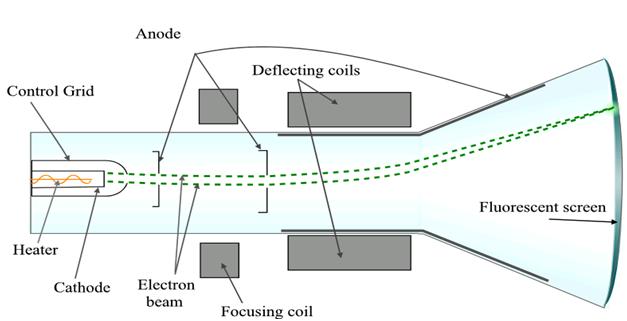
Electrons
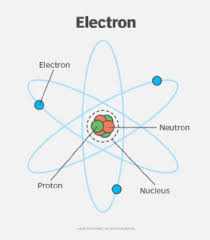
Properties of Electrons, Protons, and Neutrons
Electrons:
- Charge: Negatively charged (-1).
- Mass: Negligible compared to protons and neutrons.
- Location: Found outside the nucleus in electron shells or orbitals.
- Role: Involved in chemical bonding and determining the chemical properties of elements.
Protons:
- Charge: Positively charged (+1).
- Mass: Approximately equal to that of neutrons.
- Location: Located in the nucleus of an atom.
- Role: Determines the identity of the element and contributes to the atomic mass.
Neutrons:
- Charge: Neutral (no charge).
- Mass: Approximately equal to that of protons.
- Location: Also located in the nucleus along with protons.
- Role: Helps stabilize the nucleus and contributes to the atomic mass.
Neil Bohr Model
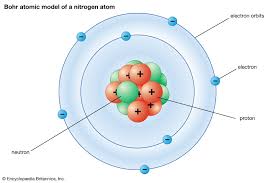 Bohr’s Model of an Atom: Niels Bohr proposed a model of the atom that addressed some of the limitations of Rutherford's model. According to Bohr's model:
Bohr’s Model of an Atom: Niels Bohr proposed a model of the atom that addressed some of the limitations of Rutherford's model. According to Bohr's model:
- Electrons revolve around the nucleus in stable orbits or energy levels.
- Each orbit has a definite energy associated with it, and electrons do not emit radiant energy while in these stable orbits.
- Electrons can jump from one orbit to another by either emitting or absorbing energy.
- These orbits or energy levels are labeled as K, L, M, and N shells, with the K shell being closest to the nucleus and having the lowest energy.
CBSE Class 9 Science Notes Chapter 4 FAQs
What is an atom?
An atom is the basic unit of matter, composed of three subatomic particles: protons, neutrons, and electrons.
Who proposed the cathode ray experiment, and what did it reveal?
The cathode ray experiment was proposed by J.J. Thomson, which revealed the existence of electrons as negatively charged particles.
What did Rutherford's alpha particle scattering experiment conclude?
Rutherford's experiment concluded that the atom has a small, positively charged nucleus at its center, with electrons orbiting around it.
What are the main postulates of Bohr's model of the atom?
Bohr's model proposed that electrons revolve around the nucleus in fixed energy levels or orbits without emitting radiation, and that each orbit has a specific energy level.
What are valence electrons, and why are they important?
Valence electrons are the electrons present in the outermost shell of an atom. They determine the chemical properties and reactivity of an element.
Talk to a counsellorHave doubts? Our support team will be happy to assist you!

Free Learning Resources
PW Books
Notes (Class 10-12)
PW Study Materials
Notes (Class 6-9)
Ncert Solutions
Govt Exams
Class 6th to 12th Online Courses
Govt Job Exams Courses
UPSC Coaching
Defence Exam Coaching
Gate Exam Coaching
Other Exams
Know about Physics Wallah
Physics Wallah is an Indian edtech platform that provides accessible & comprehensive learning experiences to students from Class 6th to postgraduate level. We also provide extensive NCERT solutions, sample paper, NEET, JEE Mains, BITSAT previous year papers & more such resources to students. Physics Wallah also caters to over 3.5 million registered students and over 78 lakh+ Youtube subscribers with 4.8 rating on its app.
We Stand Out because
We provide students with intensive courses with India’s qualified & experienced faculties & mentors. PW strives to make the learning experience comprehensive and accessible for students of all sections of society. We believe in empowering every single student who couldn't dream of a good career in engineering and medical field earlier.
Our Key Focus Areas
Physics Wallah's main focus is to make the learning experience as economical as possible for all students. With our affordable courses like Lakshya, Udaan and Arjuna and many others, we have been able to provide a platform for lakhs of aspirants. From providing Chemistry, Maths, Physics formula to giving e-books of eminent authors like RD Sharma, RS Aggarwal and Lakhmir Singh, PW focuses on every single student's need for preparation.
What Makes Us Different
Physics Wallah strives to develop a comprehensive pedagogical structure for students, where they get a state-of-the-art learning experience with study material and resources. Apart from catering students preparing for JEE Mains and NEET, PW also provides study material for each state board like Uttar Pradesh, Bihar, and others
Copyright © 2025 Physicswallah Limited All rights reserved.
Get App
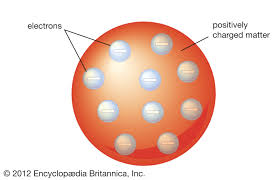 Thomson's model of an atom, proposed by physicist J.J. Thomson in 1904, is often referred to as the "plum pudding" model. According to this model, the atom is envisioned as a uniform, positively charged sphere with negatively charged electrons embedded within it, akin to plums in a pudding. In this representation, the positive charge is spread out evenly throughout the atom, while the electrons are scattered throughout the positively charged sphere.
This model implies that the atom has no overall charge and seeks to explain the stability of the atom despite the presence of negatively charged electrons. However, later discoveries and experiments led to the refinement of this model, ultimately paving the way for the development of more accurate atomic models, such as Rutherford's nuclear model and Bohr's planetary model.
Thomson's model of an atom, proposed by physicist J.J. Thomson in 1904, is often referred to as the "plum pudding" model. According to this model, the atom is envisioned as a uniform, positively charged sphere with negatively charged electrons embedded within it, akin to plums in a pudding. In this representation, the positive charge is spread out evenly throughout the atom, while the electrons are scattered throughout the positively charged sphere.
This model implies that the atom has no overall charge and seeks to explain the stability of the atom despite the presence of negatively charged electrons. However, later discoveries and experiments led to the refinement of this model, ultimately paving the way for the development of more accurate atomic models, such as Rutherford's nuclear model and Bohr's planetary model.
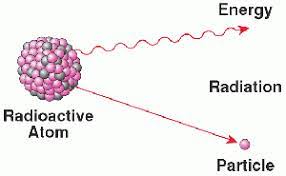 Radioactivity is a natural process where the unstable nucleus of an atom emits energy in the form of particles or electromagnetic waves. This phenomenon occurs spontaneously in certain types of atoms, particularly those with an imbalance of protons and neutrons in their nuclei.
During radioactivity, particles such as alpha particles (consisting of two protons and two neutrons) or beta particles (electrons or positrons) are emitted from the nucleus. These emissions help the unstable atom achieve a more stable configuration. Since radioactivity is an intrinsic property of certain atomic nuclei, it occurs independently of external influences.
Radioactivity is a natural process where the unstable nucleus of an atom emits energy in the form of particles or electromagnetic waves. This phenomenon occurs spontaneously in certain types of atoms, particularly those with an imbalance of protons and neutrons in their nuclei.
During radioactivity, particles such as alpha particles (consisting of two protons and two neutrons) or beta particles (electrons or positrons) are emitted from the nucleus. These emissions help the unstable atom achieve a more stable configuration. Since radioactivity is an intrinsic property of certain atomic nuclei, it occurs independently of external influences.
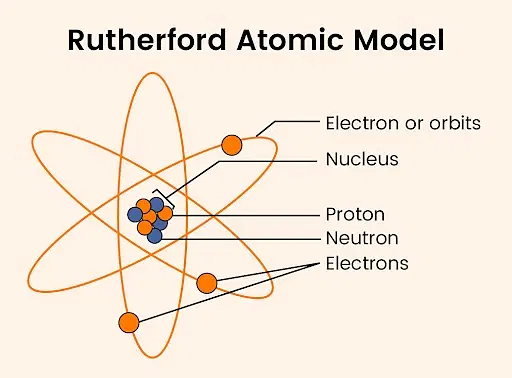 The Rutherford model, proposed by physicist Ernest Rutherford in 1911, revolutionized the understanding of atomic structure. In this model, Rutherford suggested that atoms have a dense central nucleus surrounded by orbiting electrons. The nucleus, which contains positively charged protons and neutral neutrons, occupies a very small volume compared to the overall size of the atom.
The electrons, which are negatively charged, orbit the nucleus in fixed paths or orbits, much like planets orbiting the sun. Rutherford's model also introduced the concept of the atomic number, representing the number of protons in the nucleus, which determines the identity of the element. Although the Rutherford model was groundbreaking, it was later refined with the development of quantum mechanics to explain the behavior of electrons in greater detail.
The Rutherford model, proposed by physicist Ernest Rutherford in 1911, revolutionized the understanding of atomic structure. In this model, Rutherford suggested that atoms have a dense central nucleus surrounded by orbiting electrons. The nucleus, which contains positively charged protons and neutral neutrons, occupies a very small volume compared to the overall size of the atom.
The electrons, which are negatively charged, orbit the nucleus in fixed paths or orbits, much like planets orbiting the sun. Rutherford's model also introduced the concept of the atomic number, representing the number of protons in the nucleus, which determines the identity of the element. Although the Rutherford model was groundbreaking, it was later refined with the development of quantum mechanics to explain the behavior of electrons in greater detail.











